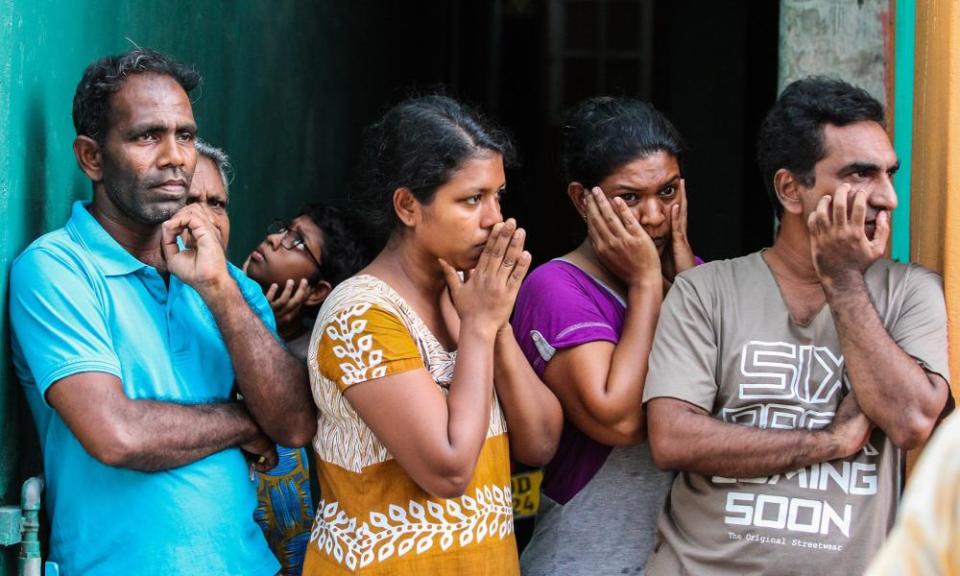‘So many lives in one day’: Sri Lankans mourn after Easter carnage

Debris was still scattered across the courtyard of St Anthony’s church on Monday afternoon when screaming filled the air again. From the dense neighbourhood surrounding the church in Colombo, one of the sites where hundreds were killed in a suicide bombing on Easter Sunday, people started fleeing into the streets in distress, many carrying wailing children. A suspicious vehicle was rumoured to be in the area. People were running for their lives.
Sri Lanka lived through nearly 26 years of civil war, one in which the tactic of suicide bombing was popularised. But Sunday’s string of attacks has cast a different kind of fear into residents of the Sri Lankan capital. “Eight explosions in one day,” said Sydney Fernando, who had helped to rescue survivors and gather body parts from St Anthony’s church. “The war was never like this: so many lives in one day, and in holy places – this is the first time in Sri Lankan history that I know of.”
Location map of Sri Lanka bombings
On Monday, the fear had not yet abated, and rage was building in the areas most affected by the killing. Police at St Anthony’s church brandished their rifles and ran to where the suspicious vehicle had been reported. They arrested a youth in a green T-shirt, but were prevented from putting him in a police car by a mob that formed around them, trying to strike the detained man.
Officers finally took refuge in a police station, surrounded by a crowd that peeled down a metal fence trying to reach the arrested youth. It was unclear why he had been detained.
A few minutes later, an explosion rocked the street, sending waves of people fleeing. “It’s a bomb, a bomb blasting,” one man announced as people ran past him screaming and in tears. “See how we are living? How can we manage like this?”
Police have now clarified it was a controlled explosion of a suspicious package found in a van https://t.co/wWfvpYHmeQ
— michael safi (@safimichael) April 22, 2019
A bomb disposal unit had concluded that the suspicious van was the one that had been used to transport the suicide bomber who had struck St Anthony’s on Sunday morning. They had blown it up as part of a controlled explosion, which appeared to have detonated bombs that were inside, a police spokesman said. Only the charred chassis of the white vehicle was left intact. It was one of at least three sites in Colombo where explosives were found on Monday.
The area surrounding the gutted church was crowded with people trying to process the previous day’s events. Gration Fernando, a wedding photographer, had heard the explosion on Easter Sunday and rushed to the church, where a priest told him to go and get his camera and take pictures for evidence.
“But I couldn’t,” he said. “I saw the bodies and I couldn’t remember my apertures and shutter speed and ISO. First I had to cover the bodies in bedsheets, so I told my son to go and get some.”

Sri Lankans living nearby watch as security forces inspect a suspicious vehicle parked near St Anthony’s church.Photograph: Anadolu Agency/Getty Images
Malcolm Perera, a labourer with the local council, struggled to find the words to describe what he had seen when he arrived at the church shortly after the bombing. “With my friends I carried 37 bodies and 50 bags of body parts,” he said. He lapsed into silence for a few moments, then started pointing at his eyes and nose, and then to the sky.
“The smell of blood is still on my body,” he said. Nearby, the clock tower of the church was frozen at 8.45am, the precise time of the explosion.
Related: Sri Lanka bombings – a timeline and visual guide
All along the road towards the building, people had put up black and white tassels, symbolising the colours of mourning in the Christian, Hindu and Buddhist religions. St Anthony’s church had been a refuge for people of all three faiths.
At St Sebastian’s church in Negombo, north of Colombo, pools of blood were congealing in the courtyard along with clothes, water bottles and shattered pieces of stained glass. Father Srilath Fonseka, who had been giving mass when a suicide bomber stepped inside on Sunday morning, was trying to comfort lines of parishioners outside his office. His forehead had been hit with shrapnel and was bandaged.
He showed people a grainy picture of the bomber, wearing glasses and a backpack, captured by CCTV. “We were just about to conclude the mass, and this guy came from [the middle of the church], waited two seconds,” he said. “He was in a hurry to come inside. He turned his back, and then blasted.”
Location map of Colombo attacks
He remembers the sound it made. “People were shouting at the top of their voice, crying, some people with blood, pieces of the body here and there,” he said.
Inside the church, investigators covered their mouths with balaclavas as they surveyed the scene. Pews were strewn across the church floor and parts of the roof and walls had been blown away.
Another priest in the courtyard said that what he was seeing was testing the most basic tenets of his faith. “If this is done by who I suspect – is this their religion?” he said. “This is insanity.
“As leaders we must ask people to love one another. But speaking as a person, I am angry.”

 Yahoo News
Yahoo News 
